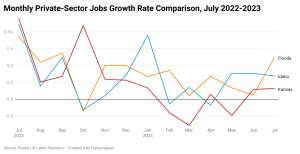Sometimes, complacency with being “good” or “OK” doesn’t match up with being “great.” All of the players in the NFL are good at football, but those who don’t take it to the next level don’t stand a chance against the Kansas City Chiefs. In the race for private-sector job growth between states, Kansas has varied from mediocre to poor economic performance over the last five decades while other states have significantly bolstered their opportunities. Significant tax reform is one key thing that Kansas can control to go from providing, at best, “OK” economic opportunities to “great” opportunities.
In July 2023, Kansas gained 1,500 private-sector jobs to end up at 1,188,900 total. This is the highest number of private-sector jobs there have been since 1,188,300 in April 2023, but still below the recent peak of 1,193,200 jobs in January 2023. The growth rate from June to July was 0.1%, but 27 other states had private-sector job growth rates that were greater than or equal to Kansas’s.
The unemployment rate dipped from 2.8% to 2.7% because of a slight decrease in the number of unemployed people and a slight increase in the number of employed people. The labor force participation rate stayed at 66.8%, so July was a positive month for people finding jobs.
Private-Sector Job Growth Comparison
This seems fine at first, until looking at other states. For instance, while Kansas floundered up and down below a monthly high in January 2023, Florida has had tens of thousands of jobs every month in a row since October 2022. In July, the state gained 42,800 jobs representing a private-sector job growth rate of 0.5%. Much of the growth comes down to economic policy.
Florida has no income tax and collects only $3,924 in state and local taxes per capita compared to Kansas’s $5,208. Low costs to start a business and low taxes have made Florida a destination for entrepreneurs leaving high-burden states like New York and California. While Florida’s biggest challenge forward is housing costs, it issued over quadruple the number of building permits for residential units than New York did in 2022.
Or take Idaho: a state that had a 0.3% growth rate last month and is 11.6% above its pre-pandemic job levels compared to Kansas’s 1.9% over pre-pandemic levels. Again, it comes back to a commitment to growth through policy choices. In Idaho in 2013, 90% of businesses were exempt from paying the personal property tax, shortly after large tax cuts in 2012. In 2022, Idaho passed a flat tax rate on the corporate and individual income tax at 5.8% during a special session because of high collections.

In the above graph, Kansas’s monthly growth has been below that of either Florida or Idaho for 11 of the 12 months between July 2022 and July 2023. Kansas also had the worst job loss in one month – March 2023 – over this period.
Governor Laura Kelly Vetos Flat Tax Proposal
This year in Kansas, a flat tax proposal failed to overcome Governor Laura Kelly’s veto. The Consensus Estimating Group for Kansas released a budget profile that predicted a massive $3 billion ending surplus in FY 2024—ending June 30, 2024–even WITH the tax relief from the flat tax bill. Opponents often beat the “Back to Brownback” drum in spite of any tax reform.
But that story is a simple one: too large of cuts without reducing spending leads to a deficit. 25 states have lower income tax rates now than when the Brownback tax cuts were implemented: If the problem was with tax reform as a whole, then these other states would have the same story. But they don’t. And in some cases, like Idaho and Florida, they’re experiencing overwhelming growth.
Right-sizing government and responsibly managing spending and taxation. Aversion to long-term tax reform is exactly the same mindset that has mired Kansas behind other states in economic growth.





